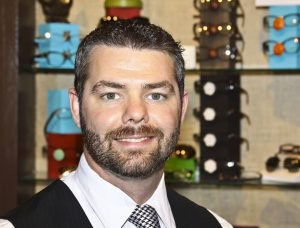
Members of Dr. Holman’s practice team. He says that training technicians to do refraction makes appointments better for both patients and doctors while increasing efficiency.
Increasing patient volume AND more time with doctor.
By Bryan T. Holman, OD
March 13, 2024
Expanding access to quality care while growing profitability are two crucial priorities of optometry practices, especially those of us striving to survive as independents.
I found that using technicians to perform most refractions is a way I can increase efficiency and patient volume without sacrificing care. Here is how and why I do this.
Allowing the Doctor to Focus on What They Do Best
I started having technicians conduct refractions in 2015.
My office was smaller. I was seeing 12-15 patients a day. However, I was doing all of the management responsibilities as I didn’t have a real office manager. Delegating refractions allowed me to see more patients per day while also freeing up more time for management duties. Over time, as my practice grew, and I could efficiently see more patients per day, I hired an office manager. I continued having technicians perform refractions because I found it so beneficial.
How Long Does it Take to Train a Tech to Do Refraction?
We train our techs in the basic tech workup first – all preliminary testing including VAs, tonometry, CVFs, etc. This usually takes 3-4 weeks. We then “check off” basic tech skills before we start teaching refraction. We work on refraction for another 2-3 weeks. That means we can train a full tech – prelims and refraction – in around two months.
I personally teach the first refracting class, and then my lead tech does follow-up coaching. I also provide feedback to techs as I am reviewing the chart data.
Why We Decided We Needed 10 Refracting Techs
Over time my River Region, Ala.-based practice grew from 12-15 patients per day to 30-35. I then acquired a second location…and then a third location. Each office has full techs with refraction skill-sets.
There are 5-6 refracting techs in my Millbrook location, three in my Greenville location and 2-3 in my Montgomery location, our newest office, which recently opened.
I intend to train more techs to refract in my Montgomery location over time. I found that for every 10-12 patients examined per day (this includes ocular disease follow-ups) that you need a refracting tech. If you want to see more patients per day then you need more refracting techs.
Other Articles to Explore
The Efficiency of Our Refracting Techs
Our techs average 5-6 minutes per refraction. This, as you know, can fluctuate based on the patient. Some patients refract quicker and some slower based on how they respond during refraction.
My techs are trained to ask the doctor when an atypical refraction is in their chair. If the patient can’t achieve 20/20, they always ask the doctor before dilating the patient. The more refractions that each tech performs over time, the better they get at sniffing out the atypical ones (latent hyperopes, keratoconus and cousins – they see this from the irregular mires on the auto-refractor, age of patient and likelihood of cataract or AMD).
If/when patients have questions about their refraction, our techs were trained to say, “I will tell the doctor that you have questions, and the doctor will review your chart and might perform another test if needed.”
With seasoned refraction techs, I only check 1-2 refractions each day. While training a tech, I recheck almost everyone.
If my average patient generates around $350, you can see how much more money we collect being able to see substantially more patients per day with help from our refracting techs.
Overall Pros & Cons of Having Techs Perform Refraction
Pros: Efficiently see more patients per day; more face-to-face doctor/patient time to discuss health and doctor’s recommendations and prescriptions.
Cons: Slightly higher payroll; and the learning curve/training schedule of techs has to be taken into account.
Effective refracting techs deserve more pay if they are willing to learn this new skill and are good at it. Not all techs that I have trained have been able to grasp refraction.
 Bryan T. Holman, OD, is the owner of River Region Vision Source, with three locations in the River Region of Alabama. To contact him: bholman@visionsource.com
Bryan T. Holman, OD, is the owner of River Region Vision Source, with three locations in the River Region of Alabama. To contact him: bholman@visionsource.com

























